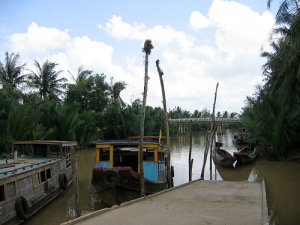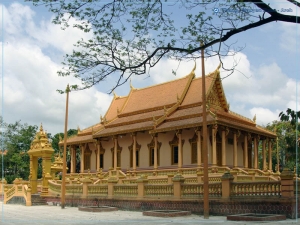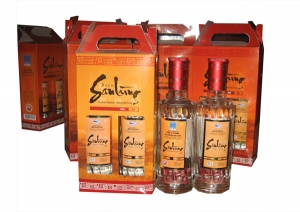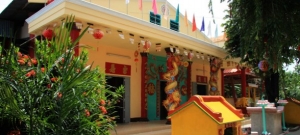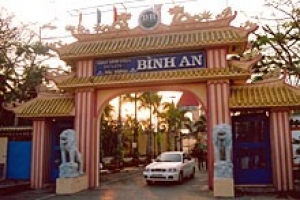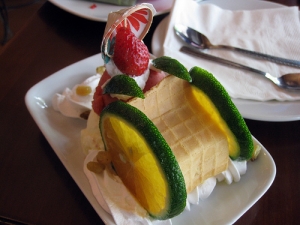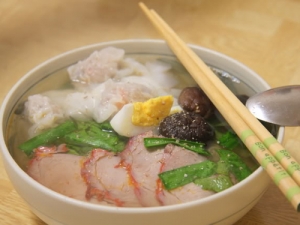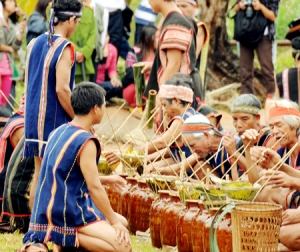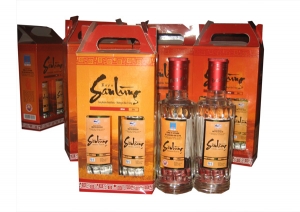
Asia Pacific Travel Team
Cu Lao Dung Islet- The Most Wealthy and Prosperous Area in Soc Trang
Rowing along Hau River with more than 40 kms long when tourists in Vietnam travel meet the end of river, there are two big mouths of river : Dinh An and Tran De – two of many main gateways to South West area. Dung islet covers an area of nearly 25,000 hectares and has the population about 58,000 inhabitants.
Dung islet is the most wealthy and prosperious in Soc Trang province. New visitors first coming to Dung Islet if not guided will be in wrong way because there are a lot of transversal pathways like a matrix. As to out side dyke borders of Dung islet, there is a total of more than 300 kms. And inside dyke borders, it’s impossible to measure them. Dyke border is the guarantee for each family’s existence which live among a vast region of river and water. People here are very hospitable. To every house, you will enjoy the specialities within their gardens such as a glass of cool coconut, an orange basket, a bunch of longan, etc.
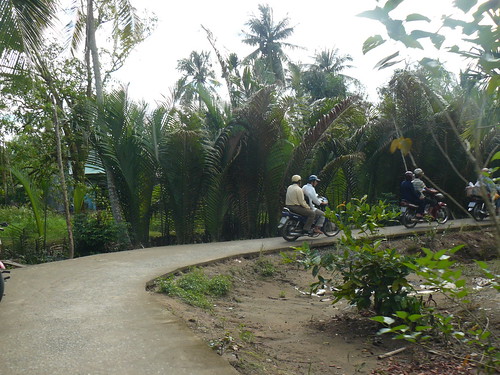
Joining tours in Vietnam and coming to Dung ilset, visitors may enjoy listening to old stories about building up the dykes, defeating the invaders by nulgar bamboos, broad sword. If by chance, you will be enjoyed the speciality of islet area, Star Godgeon cooked with brine – a countryside dish but you will never forget its taste. This fish is only bigger than our big toe,but its liver is as big as its belly. The nutty taste of its liver together with the pungent taste of vegetables will be very delicious. When the sun sets gradually, having the bobbing feeling on Ban and Trang irrigation ditch, you enjoy full of the beauty and poetry of Islet area. Moreover, there are a lot of fire –fly lights as the flower –garlant festival on the tide.
Coming to Soc Trang, you are warmly welcomed to visit this hospitable and green islet.
Khleang Pagoda among Soc Trang’s Most Ancient Pagodas
The Khleang Pagoda, one of the most ancient pagodas in Soc Trang province, features an architectural style similar to the pagodas of Cambodia. It is situated at 71 Mau Than Road, Group 5, Ward 6, Soc Trang City.
Built in 1533, it was originally made of wood with a roof thatched with palm leaves. The pagoda was later reconstructed with brick, and the roof was covered with tiles.
The pagoda consists of a central chamber and a range of wooden still-houses, used as places for holding traditional ceremonies and for housing the pagoda's monks.

Khleang pagoda- Soc Trang province
Additionally, there is a tower containing ashes of the dead, a cremation chamber, a guesthouse, and the Pothi School for teaching the Khmer language.
The Khleang Pagoda also houses writings from ancient books, which tell about the origins of Soc Trang and the pagoda.
Traveling to Soc Trang province, this ancient pagoda cannot be ignored by visitors in Vietnam travel.
Vienam of Revolution Museum
The visit to Hanoi Museum of Vietnamese Revolution would be a time to understand the changing times of the society that ranges from the Vietnamese streets to the seats of power. The objects on display offer insight into the culture of Vietnam.
The Museum of Vietnamese Revolution in Hanoi was established in 1959 and documents country's struggle for independence and also the history of the Communist Party. The museum showcases the images from 1858 to the present.
The visit to Hanoi Museum of Vietnamese Revolution would be a time to understand the changing times of the society that ranges from the Vietnamese streets to the seats of power. The objects on display offer insight into the culture of Vietnam.
The artifacts in the Museum of Vietnamese Revolution in Hanoi includes a jar of 1920's that stored the revolutionary documents, Japanese Buddhist Drum that was played during the rally and Vietnam's first sewing machine. Here one would find several photographs and other documents capturing the moments of independence.
The display at the Museum of Vietnamese Revolution in Hanoi can be highlighted in the following topics-National Liberation Movement of Vietnam against the French before the Communist Party was established (1858- 1930), Independence struggle under Communist Party (1858- 1975) and construction of the Socialist regime (1976- 1994).
The Museum is open Monday to Sunday from 8 am to 11. 30 am and 1.30 pm to 4 pm.
Soc Trang’s Clay Pagoda Recognized as Cultural and Historical Relic of The Mekong River Delta
Clay Pagoda is situated at the heart of Soc Trang City, with the original name of Buu Son Tu. From the outside, the pagoda looks like a resident house, without any pillar or wooden panel like typical pagoda architecture.
The pagoda known for its clay Buddha statues has been recognised as a historical and cultural relic of the Mekong Delta Province of Soc Trang.
Like the Tan Long Stock Garden, Clay Pagoda is another privately owned attraction in Soc Trang. Built by the Ngo family more than 200 years ago, the pagoda is now run by members of the family's fourth generation. Coming to the pagoda, visitors in Vietnam travel can see 1,901 Buddha statues, 200 animal statues, along with other worshipping items made of clay by Mr. Ngo Kim Tong during his 42 years of life. And his Ngo family will surprise you with many more stories during your visit to the Clay pagoda. You will soon find out that the pagoda also houses very special candles, each of which can be as heavy as 200kg and as tall as 2.6m. The pagoda patrol said that each candle will take about 70 yeas to burn.
Recently, Clay pagoda has become an attractive address for tourists joining tours to Vietnam to Soc Trang.
Vietnam museum of Ethonology
Vietnam Museum of Ethnology is both a research centre and a public museum exhibiting the ethnic groups of Vietnam. The mission of the Museum is scientific research, collection, documentation, conservation, exhibition and preserving the cultural and historic patrimony of the nation’s different ethnic groups. The museum also serves to guide research, conservation, and technology that are specific to the work of an ethnographic museum. In its planning for the future, the Museum intends to present the cultures and civilisations of other countries of South-East Asia as well as in the region.
Vietnam is a multi-ethnic country, which is composed of 54 ethnic groups. Perceiving the importance of having an ethnographic museum to preserve and present the cultural heritages of ethnic groups, the Government decided to establish a museum of ethnology in Hanoi. The Proposal for the Vietnam Museum of Ethnology was officially approved on December 14, 1987. Land was allocated for construction: in 1987, 2,500m2 and in 1988, 9,500m2. Then, in 1990, the Prime Minister decided to allocate the entire 3,27 acres of land to the Museum.
During construction (1987 to 1995), the Project Managing Board and the Museum Department were a part of the Institute of Ethnology. On October 24, 1995, the Prime Minister made the decision on establishment of the Vietnam Museum of Ethnology, under National Centre for Social Sciences and Humanities. On November 12, 1997, the Vietnam Museum of Ethnology inaugurated its permanent exhibition and officially opened to the public.
The Museum is located in a large open area on Nguyen Van Huyen Street, Cau Giay District, about 8 km from the city centre. This area used to be paddy field of the local people. During the construction of the Museum, all of the infrastructure was built, including the 700m road from Hoang Quoc Viet Street to the entrance of the Museum. (In the near future, this road will reach the Daewoo Hotel, which is situated between Cau Giay and Lieu Giai Streets)
The Vietnamese Government first invested in the Museum in 1986 and construction of the foundation began in late 1989. According to the proposal, the total budget for construction was 27 billion of Vietnamese dong (US$ 1.9 million), not including 4 billion dong (US$ 285,000) for collecting and exhibiting the artefacts.
The exhibition building of the Museum was designed by the architect Ha Duc Linh, a Tay minority, who works for the Living Houses and Public Works Building Company, Ministry of Construction. The interior architecture was done by Mrs. Veronique Dollfus, a French architect.
The Museum is divided into two parts: an indoor and an outdoor exhibition. The indoor part is composed of the exhibition building, office, research centre, library, storage, technical lab and auditorium. These offices cover 2,480m2, including 750 m2 for storage of artefacts. The outdoor exhibition, which will be accomplished in the first years of the 21st century, is to highlight different types of houses in all parts of Vietnam. Pathways link the indoor and outdoor exhibitions with each other.
Since its inauguration on the occasion of the 7th Summit of Francophony in Hanoi, give date the Museum receives about 60,000 visitors annually.
What is new at the Vietnam Museum of Ethnology?
The Vietnam Museum of Ethnology is a valuable centre for the exhibition and the preservation of cultural heritages of the 54 ethnic groups in Vietnam. To date, the Museum has collected 15,000 artefacts, 2,190 slides, 42,000 photographs, 237 audiotapes, 373 videotapes and 25 CD-ROMs. It is also a centre for ethnographic research employing many experts on the different ethnic groups. People come to the Museum just not to visit or entertain, but also to learn about these ethnic groups, their cultural diversity and the uniqueness of each group and region, as well as traditional values throughout the Vietnamese country. For this reason, national and international visitors, children and students, professionals and non-professionals are attracted to the Museum.
The artefacts of the Museum are not only priceless antiquities, but many are everyday objects, such as knives, baskets, garments, flutes, pipes and mats. These objects reflect tangible and intangible cultural heritages of the communities, representing lives and creative activities of the people. Thus, artefacts of the Museum are so varied that they are organised into different collections. The Museum has 54 collections of each individual ethnic group. Functionally classified, there are collections of clothing, jewellery, of agricultural tools, fishing instruments, weapons, household utensils and musical instruments. In addition, there are collections of artefacts related to the various religions, beliefs, wedding ceremonies, funeral ceremonies and other social and spiritual activities. Based on the specific collections, the Museum organises exhibitions and publishes books and catalogues in different formats in order to meet the needs of various audiences of different backgrounds.
The two-floor building, which is inspired by the Vietnamese famous and ancient bronze drum, holds the permanent collection. A granite bridge leads from the main gate to the entrance of the exhibition, creating a feeling of going up to a house-on-stilts which is very popular in many areas of Vietnam. On entering the Museum, the granite floor is decorated with dark tiles arranged in the shape of an S. This decoration symbolises the shape of the Vietnamese coastline, the earth is in dark colour and the ocean is light grey.
The Vietnam Museum of Ethnology has been designed to reflect the country's technical and scientific progress as well as the Museum’s objectives. First of all, the Museum was created for everybody. This is reflected in both the architecture and the display techniques. The Museum has ramps for physically challenged people and an electric elevator allowing access to the second floor. All steps have handrails that are very comfortable for older people. Learning from the experiences of many museums in the world, the museum texts are not in capital letters but small letters so that it is easy for people of different ages to read them. Panels are presented at reasonable heights, for both adults and children. In addition to objects, there are photographs, texts, videos and many reference materials, all of which can be brought into full play to inform visitors with different levels of education and different needs.
The objects are displayed as centrepieces because they reflect the everyday lives of the people. The Museum’s consistent point of view is that the display should be simple, so that visitors can admire the beauty and finesse of each ordinary and simple item. Although there are no illustrative paintings in the Museum, photographs and videos are used to illustrate people’s lives.
A restricted number of 700 objects and 280 photographs are displayed in the Museum’s permanent exhibits, which helps
visitors avoid being distracted by an over-representation of artefacts. The different collections are displayed according to language groups and territories. Most of the objects presented in the 97 showcases are original. The showcases have either one-sided windows or four-sided windows, depending on the artefacts presented. For example, some cases present many artefacts; others have only one significant object. Among the showcases in the display, 50 cases are accompanied by texts. Each object has a label denoting its name, the ethnic group and the place where it was created. There are also mannequins, maps, graphs, hardcover books, photographs, videotapes, cassette tapes, models, and 33 section panels. Though the Museum is not large, dioramas highlight certain customs or cultural features of ethnic groups.
Adding to the many layers of information available to visitors, the museum provides hundreds of panels composed of explanations, illustrative photographs and maps. Unfortunately, because of limited space, the texts are condensed. Not only do the texts and the object labels serve a national audience, they are also translated into English and French in order to facilitate international visitors. Thus, visitors experiencing the museum, even without a tour guide, are able to understand the main messages of the displays.
New technical solutions have been used throughout the Museum, such as focused lights. The light radiates inside and outside the glass windows focusing on the most significant aspect of each object in order to set off its beauty and draw visitors’ attention. In addition, a ventilation system has been installed within each display area to protect the objects from mould and decay.
The outdoor exhibition area is only large enough for the most popular architectural styles to be represented. Already presented are the Ede long house, the Tay stilt house, the Yao house half on stilts, half on earth, the Hmong house whose roof is made of pomu wood, the Viet house with tile roof and the Giarai tomb. There are future plans to present the Bahnar communal house, the Cham traditional house and the Hanhi house made with beaten walls. Between the houses, there are trees indigenous to the area of each house, zigzagging paths and a meandering stream crossed by small bridges. The outdoor museum is being realised step by step.
Binh An Tourist Resort in Soc Trang
Situated at No. 71, Ward 2, Soc Trang Town, Soc Trang Province; by the Highway No. 1A, Binh An Tourist Resort resembles Dam Sen Cultural Park in Ho Chi Minh City, but in a smaller scale.
Coming here, tourists in Vietnam travel have opportunities to join many recreation and entertainment activities. The tree-lined road system, the network of swimming pools, fishponds and other facilities are well arranged. That is the reason why this resort is suitable to tourists, with their different tastes and hobbies.

Behind the gate lies a man-made mountain 30 to 40 meters high. Atop the mountain stands a big statue of Avalokitesvara. At the foot of the mountain there are fishponds and paths. Inside the mountain is a mini hotel. Next to the mountain stands a two-storey villa built in the mixed Russian and Chinese architectural style, where wedding ceremonies, parties or banquets can be held.
The Binh An Tourist Resort has stirred up the atmosphere of a peaceful town imbued with Khmer cultural identity in Soc Trang, a province of the western part of south Vietnam.
Taste excellent delicious Fanny's Ice Cream in Hanoi
One of the main attractions around Hoan Kiem Lake is Fanny's Ice Cream shop on the west side of the lake.
The brand of Fanny Ice Cream in Vietnam appeared in 1995, founded by Mr. Jean-Marc Bruno, who graduated from Le Notre Paris, the leading famous place training experts producing types of the French icecream and cake.
Fanny, one of the most famous and oldest icecream brands in Vietnam, is highly appreciated by experts and customers. Currently, beside five stores chain, Fanny has over 1,000 customers including restaurants, hotels, resorts, large and small supermarkets across the whole country.
It always focuses in ensuring good quality for its products. With modern production lines, experienced staff, non-stop creativity, Fanny always creates many kinds of Ice creams to meet the needs of customers, typically " special cream "every month or for the holidays.
To celebrate a new store at 51 Ly Thuong Kiet street, Hanoi, Fanny will send gift coupon worth VND20,000 for all the bills; donate a cup of Espresso for all the bills over VND 350.000 (applied from 9.30 am August 15 until August 30). In addition, ice cream buffet is normally held on the first Friday of the month from 18h30 to 23h.
Address: Fanny Ice Cream Shop - 51 Ly Thuong Kiet, Hoan Kiem District, Hanoi. Tel: (04) 393 978 170. Website: http://www.fanny.com.vn/; http://www.facebook.com/FannyJointStockCompany.
Translated by HT
Some most famous "Van Than" Noodle shops in Hanoi
No one could remember exactly when Van Than noodle appeared in Hanoi, just know that food has followed by Chinese from the 30s of last century.
Van Than noodle called his beautiful Chinese name is "Vân Thốn" - which means "swallowing cloud". The original noodle was not suitable taste of Hanoian, so for a long time this dish has much less known. Understanding that, the hanoian has skillfully processed to fit Vietnamese tastes.
Not only put a handful noodles, a few pieces of Van Than, two or three thin slices of liver, mushrooms, barbecue pork into a bowl to make it become delicious noodles.
A full bowl of noodles include noodles, Vằn Thắn (also known as Sủi Cảo). Noodle made from flour and egg, then rolled to a long and fibers, to maintain eye-catching yellow colour.
Also, the chef will add more barbecue pork, mushrooms, a slice of boiled egg, slice the ball, vegetables, shallots and fresh peeled shrimp in the noodle bow. A delicious broth from chicken bones, pork bones, dried sturgeon, some medicine and the shrimp -shell and add a little salt in the broth pot after many hours of boiling.

Van Than's centre includes fresh peeled shrimp, pork and mushrooms

Xa Xíu helps the dish more flavour
Perhaps because it's hard to be a delicious broth, so not many shops in Hanoi selling Van Than. You could lead your family or friend to taste typical dishes of in Hue, Dinh Liet, Hang phen, or in Mai Hac De street in Hanoi capital.
Translated by HT
Source: The box
Vietnam Travel Guide - Vietnam Travel Company - Tours in Vietnam
Can wine ( Rượu cần)- A famous wine in the Tay Nguyen region
Can Wine (also called tube wine) is a fermented rice wine produced in Vietnam, in particular in mountainous areas like Tay Nguyen area.
How to make the wine?
It is made of cooked glutinous rice (nếp) mixed with some kinds of herbs in the local forests. The types and amount of herbs added differs according to ethnic group and area. This mixture is then put into a large earthenware jug, and allowed to ferment for at least one month. Can wine's strength is typically 15 to 25 percent alcohol by volume.
Simple available local materials are altogether fermented by wild herb in a pottery jar for day. Its taste is total different from rice alcohol or any kind of wine - so bitter or strong that may lead you dizziness. Its sweet taste would make you drunk without any predictable consciousness.
When ís the wine served?
Can Wine (rượu cần) is typically drunk for special celebrations or ceremonies such as weddings, festivals, or harvest feasts. It is often drunk by in a nhà rông, a fire, or community house. People oftens dance and play music (in Tay Nguyen) after drinking. When you are invited to drink rượu cần by the locals, it means that you are seen as distinguished guest.
Source: vietnam-beauty.com
San Lung wine- a speciality of Sapa
There are two kinds of San Lung: the light black brown and white crystal color. San Lung wine is said to be the “fairy wine” with the feeling of cheery and acry without headache.
Tasting the wine in the morning, you could be supported by God's power and would work without feeling tired. If drinking it at night with your friends, there seems to be invisible rope connecting the two to make people speak out the nice words which could be said in no other time.
According to the Dao people, an ethnic minority of Vietnam, San Lung is wine of God made from Po Sen stream which is always cool all year- round. The North mountain area is very immense with many precious and strange leaves and forest products. That special conditions have made the special feast of San Lung. The feast is required to have enough taste of prevent cold, flu, blood circulating etc. The paddy is chosen from terraced field rice. People soak the paddy until it has sprout before stewing with herb leaves. San Lung – Bat Xat district – Lao Cai province is currently a famous destination for tourist to taste this kind of wine.
Source: winetour.biz


